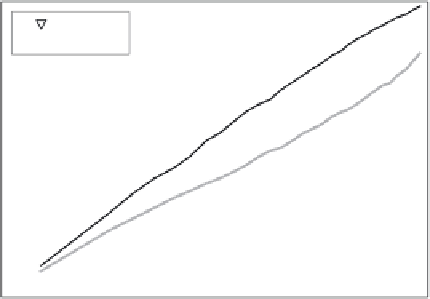Graphics Reference
In-Depth Information
1
g = 0.9
g = 0.0
0.8
0.6
0.4
0.2
0
0.2
0.4
0.6
0.8
1
Ratio of scattering (scattering albedo)
Figure 4.12
Importance of multiple scattering. The effect of multiple scattering dominates as the scat-
tering albedo approaches 1, whether the scattering is isotropic or has a strong forward bias.
(From [Jensen and Buhler 02]
c
2002 ACM, Inc. Included here by permission.)
of the simulation results for a medium with isotropic scattering (
g
=
0
.
0) and a
medium with strong forward scattering (
g
9) as a function of the scattering
albedo. The vertical axis is the ratio of light from multiple scattering to the total
exitant light. The plots shows that multiple scattering becomes more dominant
with increasing albedo in both cases. In the anisotropic case, multiple scattering
dominates entirely as the albedo approaches 1. From this the authors concluded
that multiple scattering was the important effect in materials exhibiting a high de-
gree of scattering, and they proceeded to develop an efficient algorithm targeting
only multiple scattering.
As described in Section 4.3.3, rendering with the dipole-based diffuse BSS-
RDF model requires evaluation of
R
d
at many surface points spread out around
=
0
.
Figure 4.13
Sample point distribution for precomputed irradiance.
(From [Jensen and Buhler 02]
c
2002 ACM, Inc. Included here by permission.)












































































